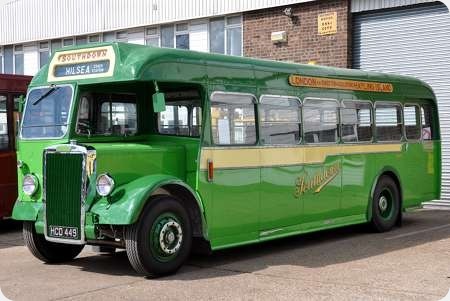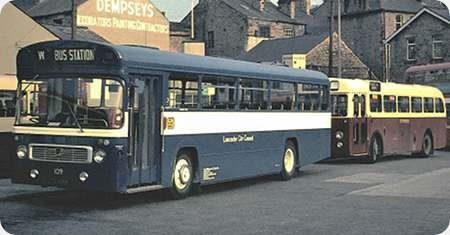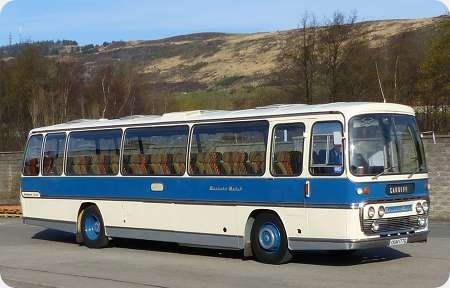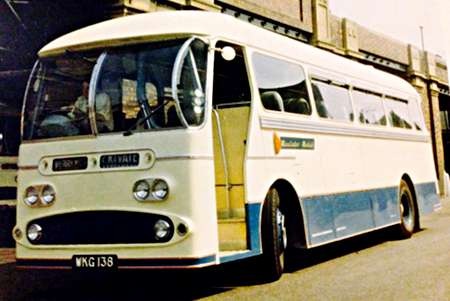Southdown – Leyland Tiger – HCD 449 – 1249
Southdown Motor Services Ltd
1947
Leyland Tiger PS1/1
ECW C31R
HCD 449 is a Leyland Tiger PS1/1 with an ECW C31R bodywork (with door!) and dates from 1947, when it joined Southdown. We see it at an open day at the Brijan Tours depot in Curdridge – just outside Botley – on 22 April 2012. These open days were always well-attended, collecting money for local charities, normally the Hampshire & Isle Of Wight Air Ambulance. Sadly, Brijan closed down in 2015.
Photograph and Copy contributed by Pete Davies
29/04/16 – 06:15
Superb in every way.
Ian Thompson
29/04/16 – 07:56
Is this another post which will spark off the old debate about DP v Coach specification? Southdown classed them as coaches but the body shell is unmistakeably bus with just a little additional brightwork embellishment. That apart it is a superb looking vehicle especially with the chromed radiator surround nicely polished.
Philip Halstead
29/04/16 – 14:29
Thanks for your comment, Ian!
Pete Davies
29/04/16 – 14:29
This particular combination of already handsome ECW body with Leyland PS1 chassis has always been particularly pleasing to me as an ardent admirer of both components.
If ever there was a vehicle where everything looks "just right" this is one. Many operators had examples of these but as far as I know only the Southdown ones had half drop windows (and very tidy louvres??)
Chris Youhill
30/04/16 – 06:28
A very interesting thought, Chris Y. I’ve just had a trawl through the contributions in respect of ECW bodies. Among them, there are plenty of single deckers, but none have the half-drop windows. Is one of the Southdown aficionados able to tell us if that operator was indeed the only one to have this combination?
Pete Davies
30/04/16 – 12:16
I am sure that I have travelled on an ECW-bodied Hants & Dorset Bristol LS B35R with half-drops in the late 1950s.
David Wragg
01/05/16 – 05:55
My favourite Southdown vehicles. As a small child in the late 50’s, I used to travel into Storrington on the service 71 which was usually operated by the 15xx East Lancs bodied Royal Tigers. Occasionally, one of these magnificent machines would turn up much to my delight. (They were downgraded from express duties to bus work after 1955).
Some were fitted with bus seats and full size destination boxes front and rear. Others remained as built. Regarding the half drop windows, there is a story that they were delivered with sliders, but altered at Portslade works before entering service. Not sure if this is truth or folklore, but Southdown had a thing about half drop windows, and all pre 1956 vehicles had them.
Roy Nicholson
01/05/16 – 17:20
Roy, according to MG Doggett & AA Townsin’s lovely book ‘ECW 1946-1965’, it would appear that Southdown had accepted most features of ECW’s ‘express’ design on its batch of Tigers, including the trim along the waistline. Interestingly though the authors go on to state: "However, there seems to have been some unease about the opening windows from early on. Some, at least, entered service with the then new ECW standard sliding vents (there being photographic evidence of body 1644 at Victoria thus), but body 1638 had much deeper sliding vents while 1640 (Southdown 1246) had full-depth sliding windows as built". An accompanying three-quarter rear view of 1246(GUF746) clearly shows the full-depth sliders, which gave the vehicle something of an ‘export model’ look. The text continues: "All of these options were considered unsatisfactory, and special half-drop windows conforming to ECW outline were fitted within a few months". The view of 1246 with full-depth sliders shows it without the louvres above the windows, so were these fitted as vehicles received their half-drop windows? Whatever the case, there is no doubt that they were handsome machines, enhanced by the application of Southdown’s distinctive livery. Beautiful.
Brendan Smith
02/05/16 – 06:44
Brendan, thanks for the information confirming the story about the half drop windows. I will keep my eyes open for a copy of said book.
Roy Nicholson
02/05/16 – 06:44
Many thanks for your further comments, folks.
Pete Davies
03/05/16 – 07:09
A real favourite of mine, especially since I once travelled on one, with my mum, back from Southsea to Kingston, in 1953. I never thought of it other than a coach, especially so as it bore the ‘coach’ script on the side. The odd ones were always the utility open-topped Guy Arab II’s who also bore ‘coach’ script, not really deserving it, although I was fond of them!
Chris Hebbron
04/05/16 – 06:21
Chris, your comment confirms my recollection that these ECW bodied PS1s were the ones used on the London – Gosport coach service that I travelled on several times as a kid between 1949 and 1952. I recall the first time I saw one before getting on it in Gosport, and marvelling at its smart appearance. Having been a great fan of the Maidstone and District pre-war Tigers when previously living in Kent, I looked forward to being treated to the glorious musical sounds that the word ‘Leyland’ had come to mean to me. Oh, how the PS1 disappointed – like hearing Stockhausen after Sibelius. The E181 engine had a very harsh rattle, even if it propelled the coach along adequately. Back in the early days of Buses Illustrated, there used to be a regular column called ‘From The Driver’s Seat’ by a certain T.A. Dalton, who, I think, worked for United Automobile. He was consistently disparaging about the E181 engine, but our own OBP expert, Chris Youhill, takes a completely opposite view, and none of us, I’m sure, would challenge Chris’s unparalleled practical knowledge on the subject. Like the Crossley and Daimler engines of the early post war period, the E181 was probably best suited to single deck applications, and the PS1 continued to be the standard Leyland saloon bus offering after the PS2 had appeared.
Roger Cox
05/05/16 – 06:53
Many thanks Roger, and I must say though that my impression of the E181 engines was as unfavourable as anyone else’s when they first appeared in 1945/6. I think initially the stark contrast with the lusty but silky smooth prewar 8.6 litre unit hit us all very forcibly, and secondly, although I have no technical knowledge on the matter, I do think that fitter unfamiliarity and poor quality fuel contributed to that harsh "knock" which they displayed. In my experience they became much more mellow and delightful in later years for whatever reason and had remarkable power when properly "tuned and fed" and driven for their 7.4 litres. No use expecting them to pull with trolleybus like power at ridiculously low road speeds in the higher ratios – that’s where proper use of the very precise gearboxes was essential – oh there now, I’m drooling again. I often think of the occasion when I was just at the start of a very busy late Saturday duty when the AEC Regent V suffered a flat rear tyre and was changed over with JUM 376, one of the original half dozen bought new in 1946. The apologetic but understanding fitter promised to return the Regent within the hour with a new tyre – I said that I’d rather keep 376 for the rest of the duty and he agreed – I had a lovely evening but we were both lucky to get away with it as, if the eagle eyed manager had spotted on Monday morning that we’d un-necessarily sacrificed 65 seats for 58 we’d have been for the high jump. In the event of course we never left anybody all evening – did somebody mutter something about "eight standing" ?? – never heard them !!
Chris Youhill
Quick links to the - Comments Page - Contact Page - Home Page




